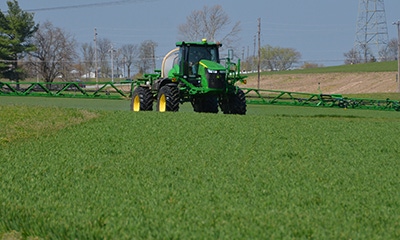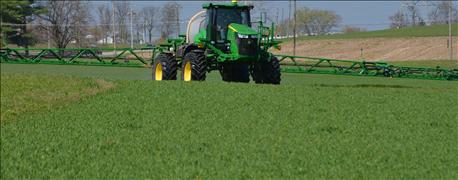
Early this week, Maryland Department of Agriculture announced that the 2016-2017 cover crop sign-up will take place June 24 through July 15 statewide at soil conservation district offices. The grants help farmers offset seed, labor and equipment costs to plant cover crops on their fields this fall to control soil erosion, reduce nutrient runoff and protect water quality in streams, rivers and the Chesapeake Bay.

EXTRA INCENTIVES: Even wheat qualifies for Maryland’s cover crop program incentives for Bay clean-up efforts.
“Last year, we had our third record-breaking cover crop planting in a row, topping out at more than 500,000 acres planted,” says Maryland Ag Secretary Joe Bartenfelder. “Adding cover crops into a cash crop rotation adds to the productivity of our farmland and the health of our waterways and the Chesapeake Bay. This sign-up period will be your only opportunity to enroll in this year’s program.”
What’s new and in it for farmers
The program covers small grains such as wheat, rye or barley, brassicas and forage radish planted after fall harvest. This year, small grain/legume mixes are also eligible. Maryland nutrient management regulations require planting cover crops when organic nutrient sources are fall-applied.
Farmers have two planting options:
* Traditional cover crops: You receive a base rate of $45 per acre and up to $30 an acre in add-on incentives for planting early and using highly valued planting practices. Traditional cover crops may not be harvested, but can be grazed or chopped for livestock forage for on-farm use after becoming well established. Killdown/suppression may take place between March 1 and June 1, 2017.
* Harvested cover crops: This option qualifies for $25 per acre with a bonus payment of $10 per acre if rye is used as the cover crop. Fertilizer may be applied after March 1, 2017. Early fertilization at green-up may be restricted.
Eligible cover crop species include . . .
The list has been expanded to give farmers more flexibility and cover crop diversity. It includes:
* Cereal grains: Wheat/speltz, rye, barley, triticale, spring oats, ryegrass and canola/rape (brassica)
* Forage radish
* Legumes: Crimson clover, Austrian winter peas and hairy vetch may be planted, but only with a cereal grain as part of a mix
Planting requirements include . . .
* Cereal grains must be planted by Nov. 5, 2016. Some species have earlier deadlines. Soil conservation districts have the planting deadlines by species.
* Any two cover crop species may be mixed at a rate of 60% cereal grains (except spring oats) and 40% legumes or radish.
* Mixes containing rye don’t qualify for the $10 per acre rye incentive.
* Mixes containing forage radish must be planted by Sep. 15.
* Mixes containing legumes must be planted by Oct.1.
* Plant cover crops after corn, soybeans, sorghum, tobacco or vegetables are harvested.
* While there’s a five-acre minimum, there’s no acreage cap.
* All seed purchased must be tested and labeled following Maryland Seed Law and Regulations.
* Seed must be free of prohibited noxious weed seeds, have a minimum 80% germination rate and no more than 16 restricted noxious weeds per pound.
* Homegrown seed must be tested for germination and noxious weeds by the Maryland State Seed Laboratory. Cost-share is available for seed testing.
* The current year's seed tag for all purchased seed must be attached to the fall certification.
* Direct deposit is now an option for faster payment.
* Applicants must be in good standing with the cost-share program and in compliance with nutrient management requirements.
For more details, click on Maryland’s Cover Crop Program . Funding is provided by the 2010 Chesapeake Bay Trust Fund and the Chesapeake Bay Restoration Fund.
About the Author(s)
You May Also Like




